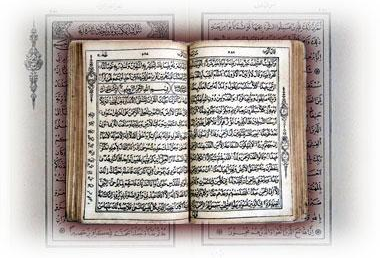Part 2 about History of Harakat in the Mushaf of the Qur’an
The naqth (dot) system, which was initiated by Abu al-Aswad, was historically still used until the time of Khalil al-Farahidy (d. 100 H./789 AD). This year’s calculation is at least based on the fact that the next phase of tahsin (efforts to beautify and simplify the Qur’an) is continued by Khalil’s efforts, as will be described in this paper.
The dot as a marker of i’rab (the sound of the end of the word) is applied as the first formulation of Abu al-Aswad, with a different color. The implementation of the system has been effective for some time, until it is felt that it raises several problems.
For the record, efforts to tahsin (beautify) the Qur’anic manuscripts after Uthman’s writing did not take place once (Al-Sholih, 1977: 91), there were at least three phases. The first phase as explained in the previous part (read: Recognizing the Elements of the Al-Qur’an Mushaf: Harakat 1) is giving the initial part of the harakat, namely by giving a dot at the end of each word. The second phase is also carried out by giving a dot on each letter to distinguish one letter from another, which will be explained in the next part, God willing. And the third phase, is the phase of perfecting harakat.
In Khalil’s time, the Qur’anic manuscripts were equipped with various points with various functions and purposes. In the disciplines of the Qur’an, it is known as naqthi’rab, or simply the point of harakat, and naqthi’jam which are nothing but dots on each letter. The two types of dots are written differently by using red for vowel points and black for letter points.
The number of dots scattered on each page of the Qur’anic manuscripts which then gave birth to problems, both for readers and writers. For readers, reading errors are not impossible to avoid because sometimes they cannot distinguish one from another. As for writers, it is considered a hassle because they always have to change colors at one time in the writing process.
Evaluation and changes are deemed necessary to take into account the existing possibilities. Quoting from Al-Farmawy, if you don’t change the vowel mark, then modify the letter’s dot. This then aroused the linguistic instincts of Khalil al-Farahidy, a language and literature expert who is also known as the inventor of the science of ‘arudl (notes and charts) (2004: 317).
By considering the possibilities above, Khalil al-Farahidy made a new formulation. Fathah which was originally a dot above the letter he replaced with a small alif that stretched from right to left above the letter. Dlammah becomes a small wawu which is also placed above the letter, and kasrah with a small ya’ without a dot under the letter.
In addition to changing the shape of the three vowels, Khalil also created a new formula for other punctuation marks, including tasydid or syiddah, sukun and hamzah. Tasydid he formulated with the head of the letter syin (ش) by removing the dot above it. Syin, is nothing but an extension of syadid. Sukun is symbolized by the head of the letter kha ‘ (خ) which means khafif or light, also by removing the dot on it. While hamzah, because of its proximity to the letter ‘ain (ع) is symbolized by the head of ‘ain (A-Farmawy, 2004: 318-320).
With the renewal of signs carried out by Khalil, it is hoped that it will provide convenience both for readers, because they are no longer confused with signs that are mixed with one another, and for writers, they can carry out the process of writing manuscripts more efficiently because between Letter lines, dots on letters and vowels are written using one type of ink color.
Khalil’s formulation was later used and applied to every manuscript of the Qur’an even today, although in fact at the beginning of its formulation, these signs were not applied to the manuscripts of the Qur’an. Its application to the manuscripts was found in the next era with slight modifications that were not substantial, more on simplification and variations in form, for example in the harakatkasrah which was originally in the form of ya’ which was then removed from the head so that only a straight line remained.
Wallahua’lam bi al-Shawab.
